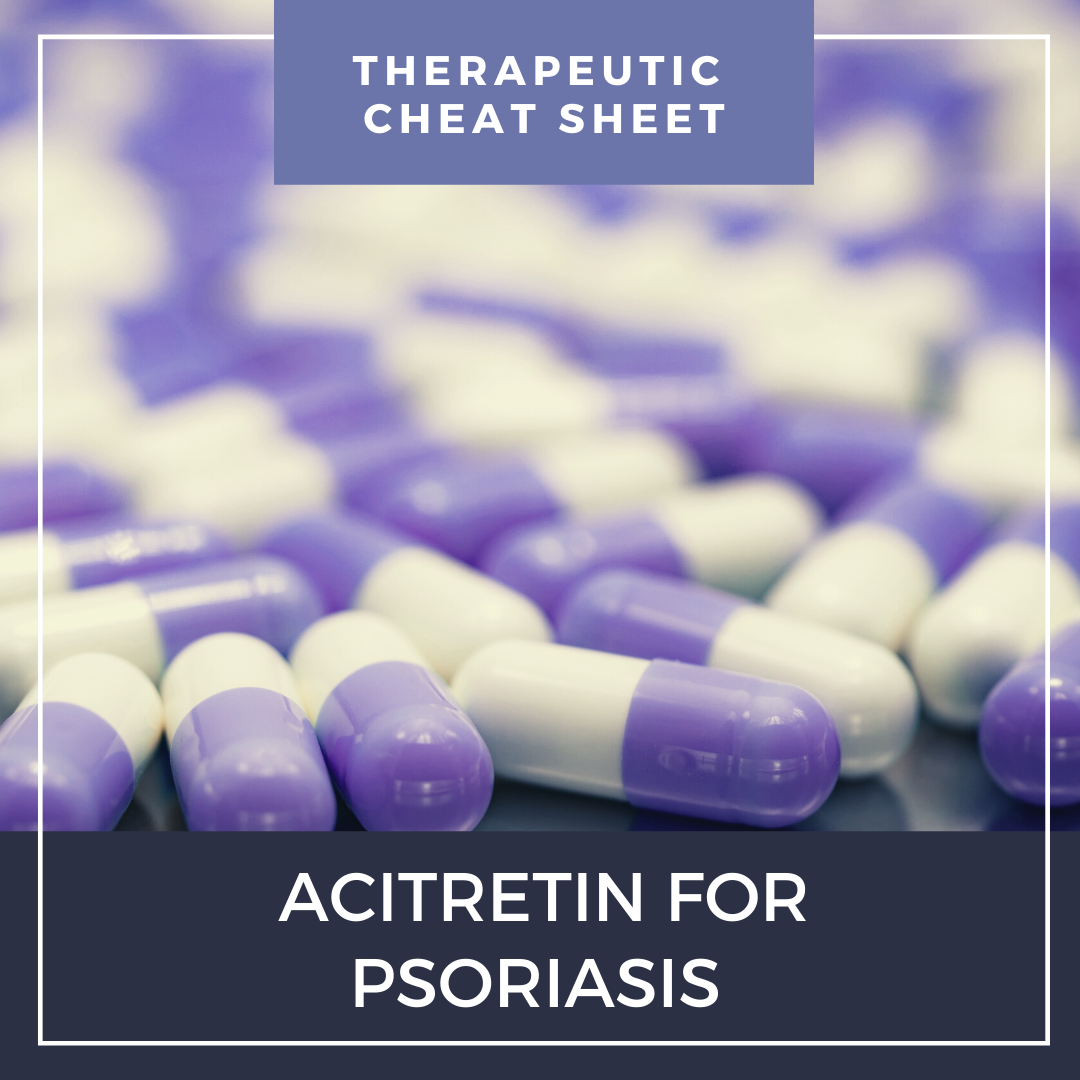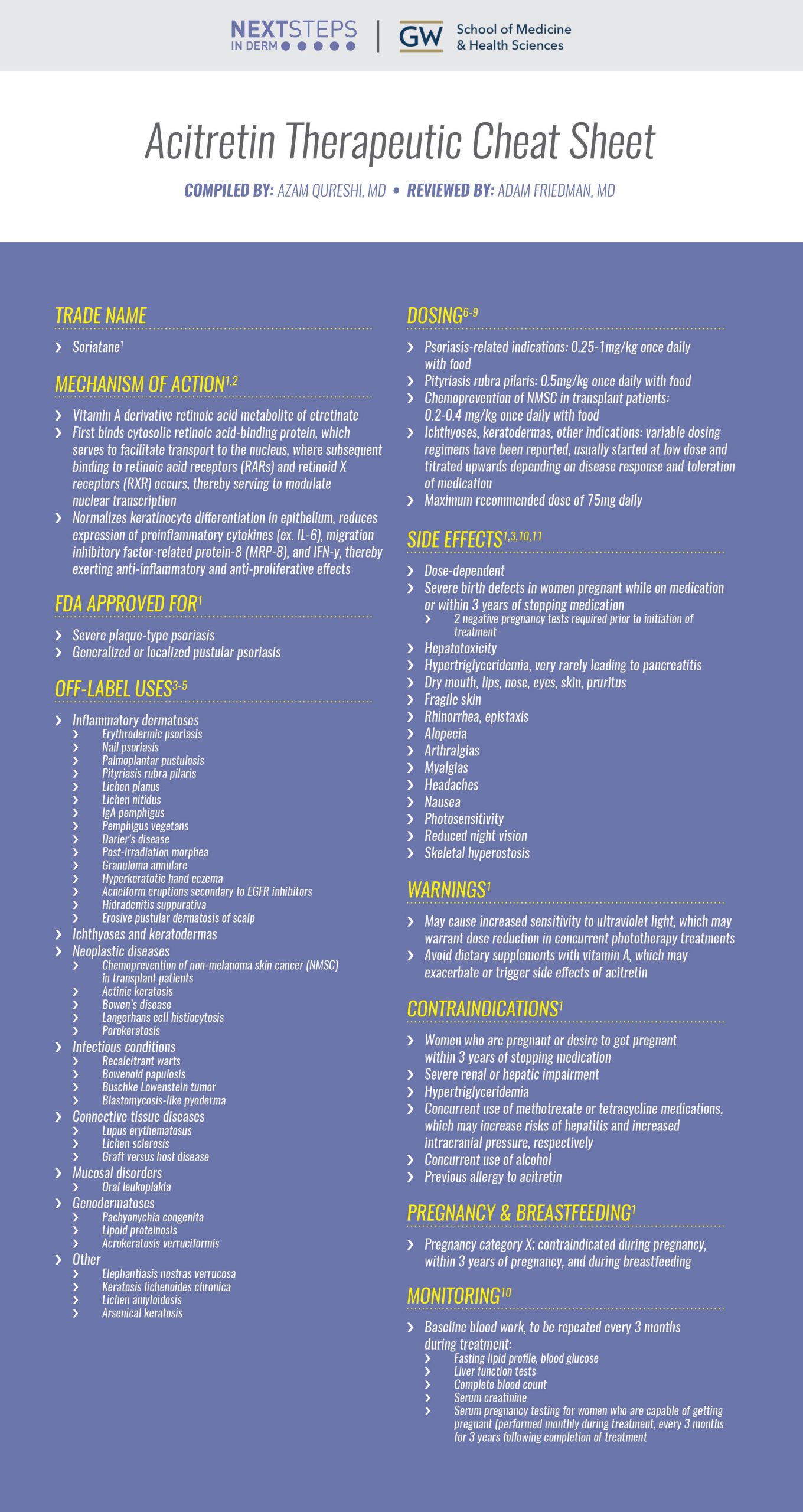Pustular psoriasis can present quickly and pose a life-threatening emergency. Acitretin is the only systemic retinoid FDA-approved for treatment of psoriasis, specifically both pustular and severe plaque-type psoriasis.1Systemic retinoids such as acitretin are utilized heavily in dermatology, and practitioners must be knowledgeable about all of the FDA-approved and off-label applications as well as the safety profile of these medications in order to provide the best possible care to patients. We continue our series, Therapeutic Cheat Sheet, with a closer look at acitretin, which is different from other systemic retinoids in terms of its indications and protocols for drug monitoring.1
Acitretin Therapeutic Cheat Sheet
Compiled by: Azam Qureshi, MD | Reviewed by: Adam Friedman, MD
ACITRETIN TRADE NAME
-
- Soriatane1
ACITRETIN MECHANISM OF ACTION1,2
-
- Vitamin A derivative retinoic acid metabolite of etretinate
- First binds cytosolic retinoic acid-binding protein, which serves to facilitate transport to the nucleus, where subsequent binding to retinoic acid receptors (RARs) and retinoid X receptors (RXR) occurs, thereby serving to modulate nuclear transcription
- Normalizes keratinocyte differentiation in epithelium, reduces expression of proinflammatory cytokines (ex. IL-6), migration inhibitory factor-related protein-8 (MRP-8), and IFN-γ, thereby exerting anti-inflammatory and anti-proliferative effects
ACITRETIN IS FDA APPROVED FOR1
-
- Severe plaque-type psoriasis
- Generalized or localized pustular psoriasis
ACITRETIN OFF-LABEL USES3-5
-
- Inflammatory dermatoses
- Erythrodermic psoriasis
- Nail psoriasis
- Palmoplantar pustulosis
- Pityriasis rubra pilaris
- Lichen planus
- Lichen nitidus
- IgA pemphigus
- Pemphigus vegetans
- Darier’s disease
- Post-irradiation morphea
- Granuloma annulare
- Hyperkeratotic hand eczema
- Acneiform eruptions secondary to EGFR inhibitors
- Hidradenitis suppurativa
- Erosive pustular dermatosis of scalp
- Ichthyoses and keratodermas
- Neoplastic diseases
- Chemoprevention of non-melanoma skin cancer (NMSC) in transplant patients
- Actinic keratosis
- Bowen’s disease
- Langerhans cell histiocytosis
- Porokeratosis
- Infectious conditions
- Recalcitrant warts
- Bowenoid papulosis
- Buschke Lowenstein tumor
- Blastomycosis-like pyoderma
- Connective tissue diseases
- Lupus erythematosus
- Lichen sclerosis
- Graft versus host disease
- Mucosal disorders
- Oral leukoplakia
- Genodermatoses
- Pachyonychia congenita
- Lipoid proteinosis
- Acrokeratosis verruciformis
- Other
- Elephantiasis nostras verrucosa
- Keratosis lichenoides chronica
- Lichen amyloidosis
- Arsenical keratosis
- Inflammatory dermatoses
ACITRETIN DOSING6-9
-
- Psoriasis-related indications: 0.25-1mg/kg once daily with food
- Pityriasis rubra pilaris: 0.5mg/kg once daily with food
- Chemoprevention of NMSC in transplant patients: 0.2-0.4 mg/kg once daily with food
- Ichthyoses, keratodermas, other indications: variable dosing regimens have been reported, usually started at low dose and titrated upwards depending on disease response and toleration of medication
- Maximum recommended dose of 75mg daily
ACITRETIN SIDE EFFECTS1,3,10,11
-
- Dose-dependent
- Severe birth defects in women pregnant while on medication or within 3 years of stopping medication
- 2 negative pregnancy tests required prior to initiation of treatment
- Hepatotoxicity
- Hypertriglyceridemia, very rarely leading to pancreatitis
- Dry mouth, lips, nose, eyes, skin, pruritus
- Fragile skin
- Rhinorrhea, epistaxis
- Alopecia
- Arthralgias
- Myalgias
- Headaches
- Nausea
- Photosensitivity
- Reduced night vision
- Skeletal hyperostosis
ACITRETIN WARNINGS1
-
- May cause increased sensitivity to ultraviolet light, which may warrant dose reduction in concurrent phototherapy treatments
- Avoid dietary supplements with vitamin A, which may exacerbate or trigger side effects of acitretin
ACITRETIN CONTRAINDICATIONS1
-
- Women who are pregnant or desire to get pregnant within 3 years of stopping medication
- Severe renal or hepatic impairment
- Hypertriglyceridemia
- Concurrent use of methotrexate or tetracycline medications, which may increase risks of hepatitis and increased intracranial pressure, respectively
- Concurrent use of alcohol
- Previous allergy to acitretin
PREGNANCY & BREASTFEEDING1
-
- Pregnancy category X; contraindicated during pregnancy, within 3 years of pregnancy, and during breastfeeding
ACITRETIN MONITORING10
-
- Baseline blood work, to be repeated every 3 months during treatment:
- Fasting lipid profile, blood glucose
- Liver function tests
- Complete blood count
- Serum creatinine
- Serum pregnancy testing for women who are capable of getting pregnant (performed monthly during treatment, every 3 months for 3 years following completion of treatment
- Baseline blood work, to be repeated every 3 months during treatment:
Acitretin is an extremely versatile instrument in the dermatologist’s toolbox, with a variety of off-label applications for difficult to treat dermatologic diseases. Practitioners should be comfortable prescribing this medication while understanding its differences from other systemic retinoids like isotretinoin and bexarotene. Patient selection and counseling is pivotal, especially for women taking this medication and for those who drink any alcohol. In the right patients, this invaluable medication can lead to clearance of various skin diseases ranging from genodermatoses to inflammatory and cutaneous proliferative diseases.
CLICK ON THE IMAGE BELOW TO ENLARGE AND/OR DOWNLOAD YOUR THERAPEUTIC CHEAT SHEET
Further Reading
To learn more about acitretin, check out the following 2 articles published in the Journal of Drugs in Dermatology:
Acitretin for Secondary Prevention of Keratinocyte Cancers in a Veteran Population: A Retrospective Cohort Study12
Authors: Rachel K. Lim, Martin A.Weinstock MD, PhD, Shoshana M. Landow MD MPH
Abstract:
Acitretin, a vitamin A derivative used for psoriasis, can prevent keratinocyte carcinoma (KC). It induced regression of keratoacanthomas (KA) in animal models, presumably by activating retinoic acid and retinoid X receptors that regulate gene expression for growth and proliferation.
Acitretin in Dermatology: A Review13
Authors: Lauren K. Dunn PhD, Laini R. Gaar MD, Brad A. Yentzer MD, Jenna L. O´Neill MD, Steven R. Feldman MD PhD
Abstract:
Introduction: Acitretin is a systemic retinoid drug used in the treatment of severe psoriasis. It has also been used for a spectrum of other difficult-to-treat dermatoses, including hyperkeratotic and inflammatory dermatoses and non-melanoma skin cancers. Here we review the available data regarding both FDA-approved and off-label uses of acitretin, clinically relevant adverse events, precautions and monitoring.
Methods: A PubMed literature search was conducted utilizing the search term “acitretin,” which yielded 714 hits. Results were further limited to English language clinical trials in human subjects. Of 78 articles evaluated for relevance, 60 were included for review.
Results: Acitretin is effective as monotherapy and in multidrug therapeutic regimens for the treatment of psoriasis and other hyperkeratotic and inflammatory disorders, as well as for malignancy chemoprevention. Its use is limited by its teratogenic potential and other adverse effects, including mucocutaneous effects and hepatotoxicity. Potential adverse effects may be reduced or avoided by using lower doses of acitretin or in combination with other therapies.
Limitations: The reviewed studies include many small trials and case reports of the use of acitretin for psoriasis. Studies of acitretin therapy for the treatment of other cutaneous disorders are limited.
Conclusion: Acitretin is a beneficial treatment for psoriasis, and should be considered when not contraindicated. Particularly when used in combination with ultraviolet (UV) phototherapy, is a safe and cost effective therapeutic strategy.
References
-
- Stiefel, GlaxoSmithKline: SORIATANE® (acitretin) Capsules. Package Insert. US Prescribing Information and Patient Information. Revised 2017 Available at https://gskpro.com/content/dam/global/hcpportal/en_US/Prescribing_Information/Soriatane/pdf/SORIATANE-PI-MG.PDF
- Zito PM, Mazzoni T. Acitretin. [Updated 2021 Jul 30]. In: StatPearls [Internet]. Treasure Island (FL): StatPearls Publishing; 2021 Jan-. Available from: https://www.ncbi.nlm.nih.gov/books/NBK519571/
- Sarkar R, Chugh S, Garg VK. Acitretin in dermatology. Indian Journal of Dermatology, Venereology & Leprology. 2013 Nov 1;79(6).
- Costello CM, Hill HE, Brumfiel CM, Yang YW, Swanson DL. Choosing between isotretinoin and acitretin for epidermal growth factor receptor inhibitor and small molecule tyrosine kinase inhibitor acneiform eruptions. Journal of the American Academy of Dermatology. 2021 Mar 1;84(3):840-1.
- George R, Weightman W, Russ GR, Bannister KM, Mathew TH. Acitretin for chemoprevention of non‐melanoma skin cancers in renal transplant recipients. Australasian journal of dermatology. 2002 Nov;43(4):269-73.
- Kromer C, Sabat R, Celis D, Mössner R. Systemic therapies of pityriasis rubra pilaris: a systematic review. JDDG J der Dtsch Dermatologischen Gesellschaft [Internet]. 2018 Dec 6; 1–17.
- Steijlen PM, Van Dooren‐Greebe RJ, Van de Kerkhof PC. Acitretin in the treatment of lamellar ichthyosis. British Journal of Dermatology. 1994 Feb;130(2):211-4.
- Jo JW, Jeong DS, Kim CY. Case of punctate palmoplantar keratoderma type I treated with combination of low‐dose oral acitretin and topical salicylic acid and steroid. The Journal of dermatology. 2018 May;45(5):609-12.
- Blanchet-Bardon C, Nazzaro V, Rognin C, Geiger JM, Puissant A. Acitretin in the treatment of severe disorders of keratinization: results of an open study. Journal of the American Academy of Dermatology. 1991 Jun 1;24(6):982-6.
- Ormerod AD, Campalani E, Goodfield MJ. British Association of Dermatologists guidelines on the efficacy and use of acitretin in dermatology. British Journal of Dermatology. 2010 May;162(5):952-63.
- Pearce DJ, Klinger S, Ziel KK, Murad EJ, Rowell R, Feldman SR. Low-dose acitretin is associated with fewer adverse events than high-dose acitretin in the treatment of psoriasis. Archives of dermatology. 2006 Aug 1;142(8):1000-4.
- Lim RK, Weinstock MA, Landow SM. Acitretin for Secondary Prevention of Keratinocyte Cancers in a Veteran Population: A Retrospective Cohort Study. Journal of Drugs in Dermatology: JDD. 2021 Feb 1;20(2):225-6.
- Dunn LK, Gaar LR, Yentzer BA, O’Neill JL, Feldman SR. Acitretin in dermatology: a review. Journal of drugs in dermatology: JDD. 2011 Jul 1;10(7):772-82.
Did you enjoy this Therapeutic Cheat Sheet? Find more here.


